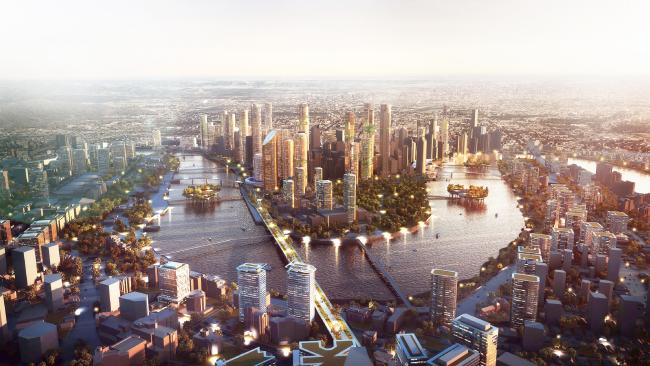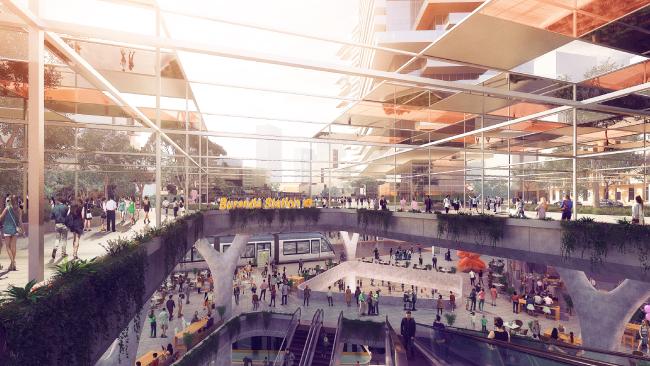Urbis was pleased to support The Courier Mail’s Future Brisbane campaign. National Design Director James Tuma reflects on the campaign, in a piece which originally appeared in The Courier Mail.
Our city harbours the ideas, talent and ambition to be a truly great future city
“In 10 years’ time, we won’t recognise many parts of our city – particularly along our wonderful river – and this is a good thing.
The Future Brisbane campaign has highlighted a great many opportunities and challenges if we are to shape the city we want to become.
Clearly the sentiment around our future is overwhelmingly positive, and the campaign has built a sense of confidence that we have the ideas, talent and ambition to deliver a city that’s the envy of the world.
For too long we have compared ourselves to our southern neighbours, competing on their terms. The tide has clearly turned. We now have the confidence and clarity of purpose that defines all great cities – we want to retain our enviable lifestyle, maintain our affordability, protect our heritage, be smart with technology, create high-value jobs, and create precincts and destinations that make us competitive on the global stage. But with these aspirations comes a necessity to change.
In 10 years’ time, we won’t recognise many parts of our city – particularly along our wonderful river – and this is a good thing.

Billions of dollars in transformative investments are on drawing boards across the city. These include the economic power of a port expansion and a second runway at the airport, a new community at Hamilton Northshore and Bulimba Barracks, a revamp of the Powerhouse, a lifestyle hub at Howard Smith Wharves, international tourism and events at Queen’s Wharf, world-class entertainment at Brisbane Live, and world-beating research at the University of Queensland and in our major hospitals.
These are projects and investments that will see our city, and the river at its heart, become one of the most attractive, economically dynamic and exciting places to be in Australia, and the world – a destination built on interconnected precincts of knowledge, entertainment, lifestyle, trade and tourism.
Change in any city can be difficult and must be approached with good planning and a clear vision.
We have both. From the recently released South East Queensland Regional Plan through to our outstanding track record in neighbourhood planning and urban renewal, the framework to successfully manage change exists.
The important element now is to shift the dialogue about change in our city from “impacts” to “benefits”.
“Cross River Rail and Brisbane Metro will utterly transform the way we move about the city in a fast, efficient and sustainable way.
For example, the location and form of density in our city is a hot topic, but it is rarely discussed from the perspective of what positive things this change brings. Apartment living is not for everyone, but it is central to providing housing and lifestyle choices, driving activity and events and, in the public realm, ensuring higher levels of access to public transport and more energetic and engaging precincts. And people are voting with their feet.
Recent research by Urbis indicates a significant proportion of renters in the city’s new apartments are from Brisbane’s outer ring; people who are consciously trading their backyard for access to coffee shops and entertainment.
Well-designed density and investment in globally relevant precincts is paramount, but their benefit is exponentially amplified when they are connected.

Commitment from the State Government and Brisbane City Council to both the Cross River Rail and Brisbane Metro is an incredible opportunity for the city that will unlock a constellation of investment and employment opportunities across the city, linking homes to jobs and people to great places.
These two projects are a defining moment in Brisbane’s history and will utterly transform the way we move about the city in a fast, efficient and sustainable way.
The experience and image of the city is important too, and we are seeing great advances in this arena.
The development of a laneway culture, including the transformation of Fish Lane in South Brisbane, the lighting of the city’s great trees, and the transformation of our waterfronts are as important as our strategic planning. These are the things that add real value to our lives and make the city more attractive.
“There is much more discussion to be had about the future of Brisbane, and plans will inevitably change, but the weight of momentum is with the city, and the future is bright.
Our climate and geography are also among our great assets. Brisbane City Council’s River’s Edge Strategy and recently released Buildings that Breathe Design Guide set a high bar for both new buildings and improved access to the river, imagining a city defined by great design, a well-used river, and one in which landscape is integrated at every opportunity. This makes the city different, identifiable and liveable – essential qualities in a globally competitive marketplace for talent, investment and ideas.
During the campaign, Urbis had the opportunity to explore some of these ideas through a series of images of “Future Brisbane”. These gave us the rare opportunity to ask “what if?” – a question that we, as a city, should continue to pose.
For example, what if autonomous vehicles allow us to reclaim half of our city streets to make eight hectares of new pedestrian spaces?
What if we use bridges and garden islands to engage with the river more?
What if South Bank extended around the Kangaroo Point cliffs and over the riverside expressway to form the biggest urban linear park network in the world?
I hope they do but, more importantly, I hope we aim high and dream big.
There is much more discussion to be had about the future of Brisbane, and plans will inevitably change, but the weight of momentum is with the city, and the future is bright.
